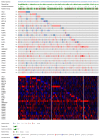Epitranscriptomics and cervical cancer: the emerging role of m6A, m5C and m1A RNA modifications
- PMID: 39377535
- PMCID: PMC11488341
- DOI: 10.1017/erm.2024.20
Epitranscriptomics and cervical cancer: the emerging role of m6A, m5C and m1A RNA modifications
Abstract
Cervical cancer (CC), one of the most prevalent and detrimental gynaecologic cancers, evolves through genetic and epigenetic alterations resulting in the promotion of oncogenic activity and dysfunction of tumour-suppressing mechanisms. Despite medical advancement, the prognosis for advanced-stage patients remains extremely low due to high recurrence rates and resistance to existing treatments. Thereby, the search for potential prognostic biomarkers is heightened to unravel new modalities of CC pathogenesis and to develop novel anti-cancer therapies. Epitranscriptomic modifications, reversible epigenetic RNA modifications, regulate various biological processes by deciding RNA fate to mediating RNA interactions. This narrative review provides insight into the cellular and molecular roles of endogenous RNA-editing proteins and their associated epitranscriptomic modifications, especially N6-methyladenosine (m6A), 5-methylcytosine (m5C) and N1-methyladenosine (m1A), in governing the development, progression and metastasis of CC. We discussed the in-depth epitranscriptomic mechanisms underlying the regulation of over 50 RNAs responsible for tumorigenesis, proliferation, migration, invasion, survival, autophagy, stemness, epithelial-mesenchymal transition, metabolism (glucose, lipid, glutamate and glutamine), resistance (drug and radiation), angiogenesis and recurrence of CC. Additionally, we provided a concise overview of the therapeutic potential of targeting the altered expression of endogenous RNA-editing proteins and aberrant deposition of RNA modifications on both coding and non-coding RNAs in CC.
Keywords: RNA modifications; RNA-editing proteins; anti-cancer therapies; cervical cancer; diagnostic biomarkers; epitranscriptomics; gene expression; m1A; m5C; m6A.
Conflict of interest statement
None.
Figures




Similar articles
-
Deciphering the Epitranscriptomic Signatures in Cell Fate Determination and Development.Stem Cell Rev Rep. 2019 Aug;15(4):474-496. doi: 10.1007/s12015-019-09894-3. Stem Cell Rev Rep. 2019. PMID: 31123982 Review.
-
RNA methylation and breast cancer: insights into m6A, m7G and m5C.Mol Biol Rep. 2024 Nov 29;52(1):27. doi: 10.1007/s11033-024-10138-y. Mol Biol Rep. 2024. PMID: 39611867 Review.
-
Integrated analysis of N6-methyladenosine- and 5-methylcytosine-related long non-coding RNAs for predicting prognosis in cervical cancer.Hereditas. 2024 Sep 16;161(1):34. doi: 10.1186/s41065-024-00336-w. Hereditas. 2024. PMID: 39285452 Free PMC article.
-
RNA Modifications and Epigenetics in Modulation of Lung Cancer and Pulmonary Diseases.Int J Mol Sci. 2021 Sep 30;22(19):10592. doi: 10.3390/ijms221910592. Int J Mol Sci. 2021. PMID: 34638933 Free PMC article. Review.
-
Writers, readers, and erasers RNA modifications and drug resistance in cancer.Mol Cancer. 2024 Aug 30;23(1):178. doi: 10.1186/s12943-024-02089-6. Mol Cancer. 2024. PMID: 39215288 Free PMC article. Review.
Cited by
-
5-Methylcytosine methylation predicts cervical cancer prognosis, shaping immune cell infiltration.J Int Med Res. 2025 Apr;53(4):3000605251328301. doi: 10.1177/03000605251328301. Epub 2025 Apr 12. J Int Med Res. 2025. PMID: 40219803 Free PMC article.
-
Integrative analysis of m6A-SNPs and single-cell RNA sequencing reveals key drivers of endocrine combined with CDK4/6 inhibitor therapy resistance in ER+ breast cancer.Front Pharmacol. 2025 Apr 15;16:1590363. doi: 10.3389/fphar.2025.1590363. eCollection 2025. Front Pharmacol. 2025. PMID: 40303916 Free PMC article.
-
Quantifying the mRNA epitranscriptome reveals epitranscriptome signatures and roles in cancer.Cell Mol Life Sci. 2025 Jul 28;82(1):290. doi: 10.1007/s00018-025-05805-7. Cell Mol Life Sci. 2025. PMID: 40719884 Free PMC article.

